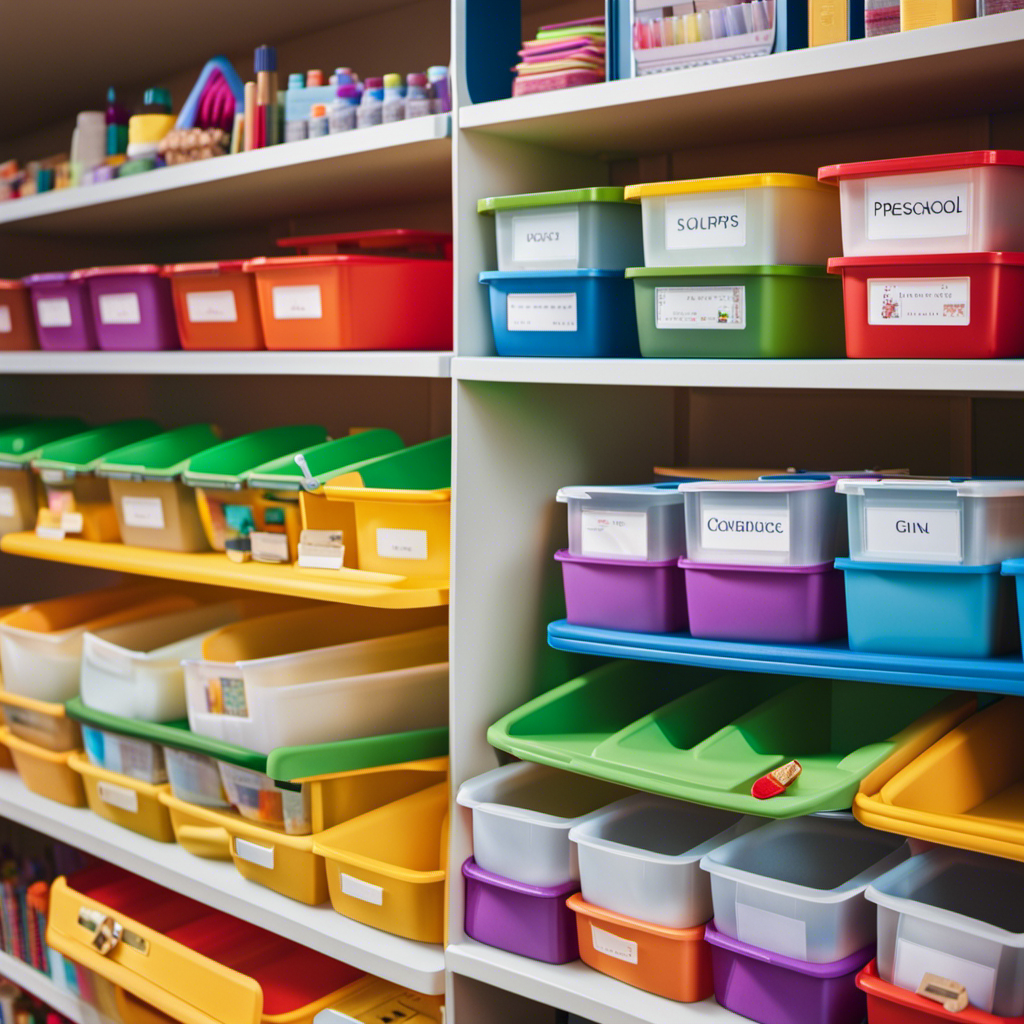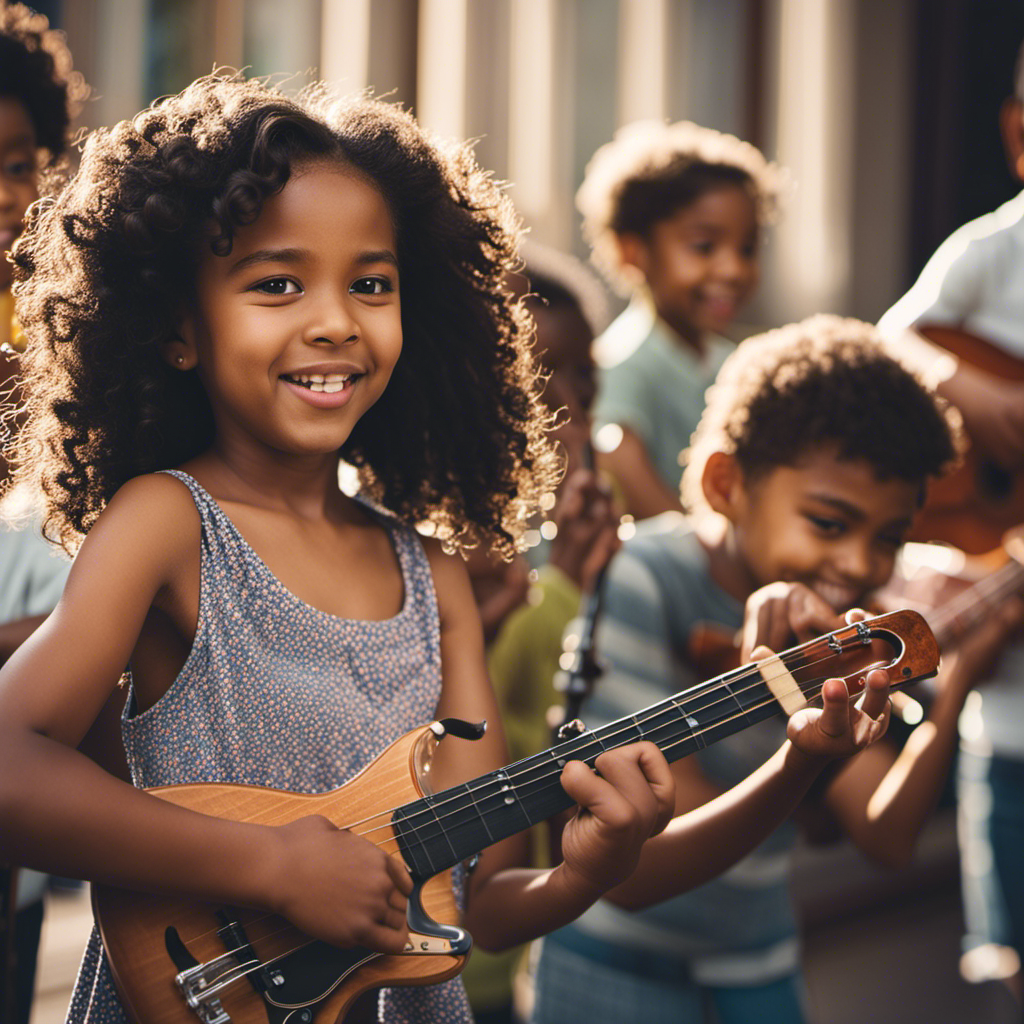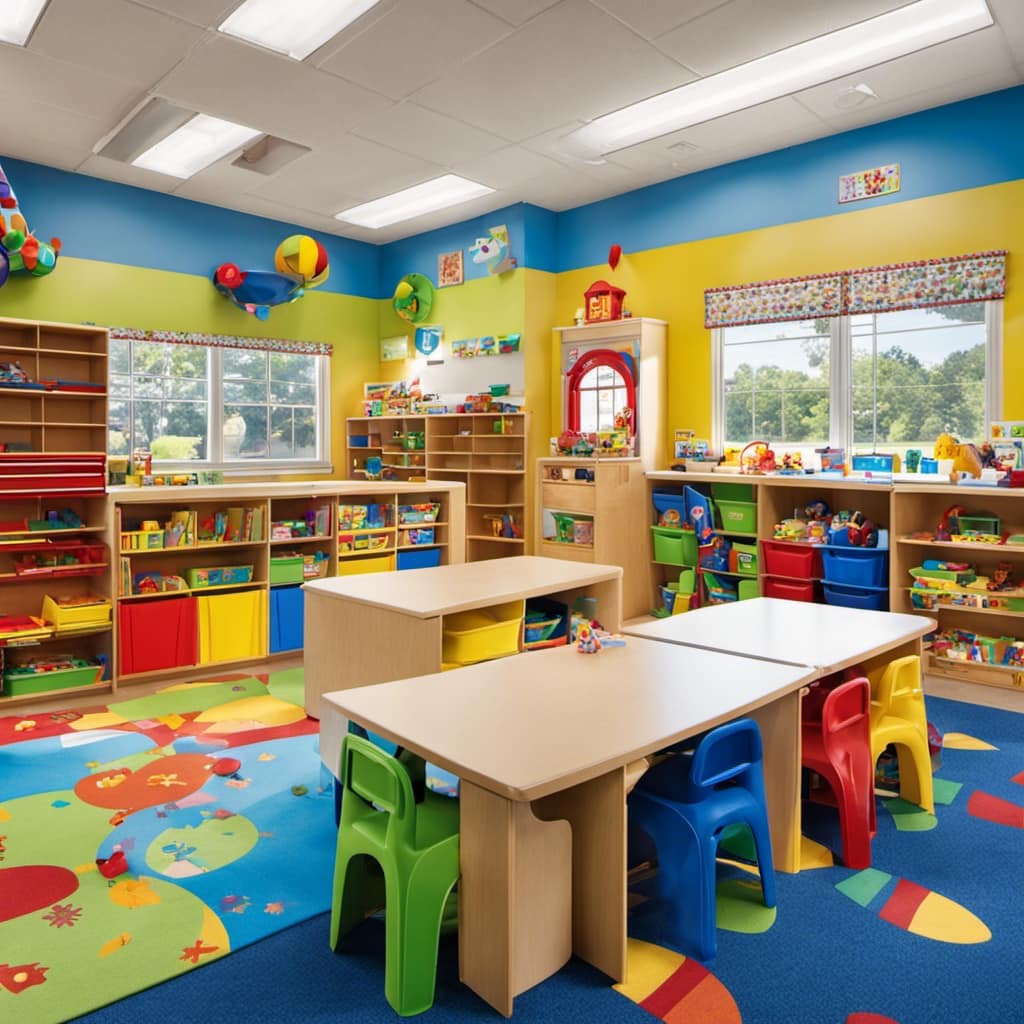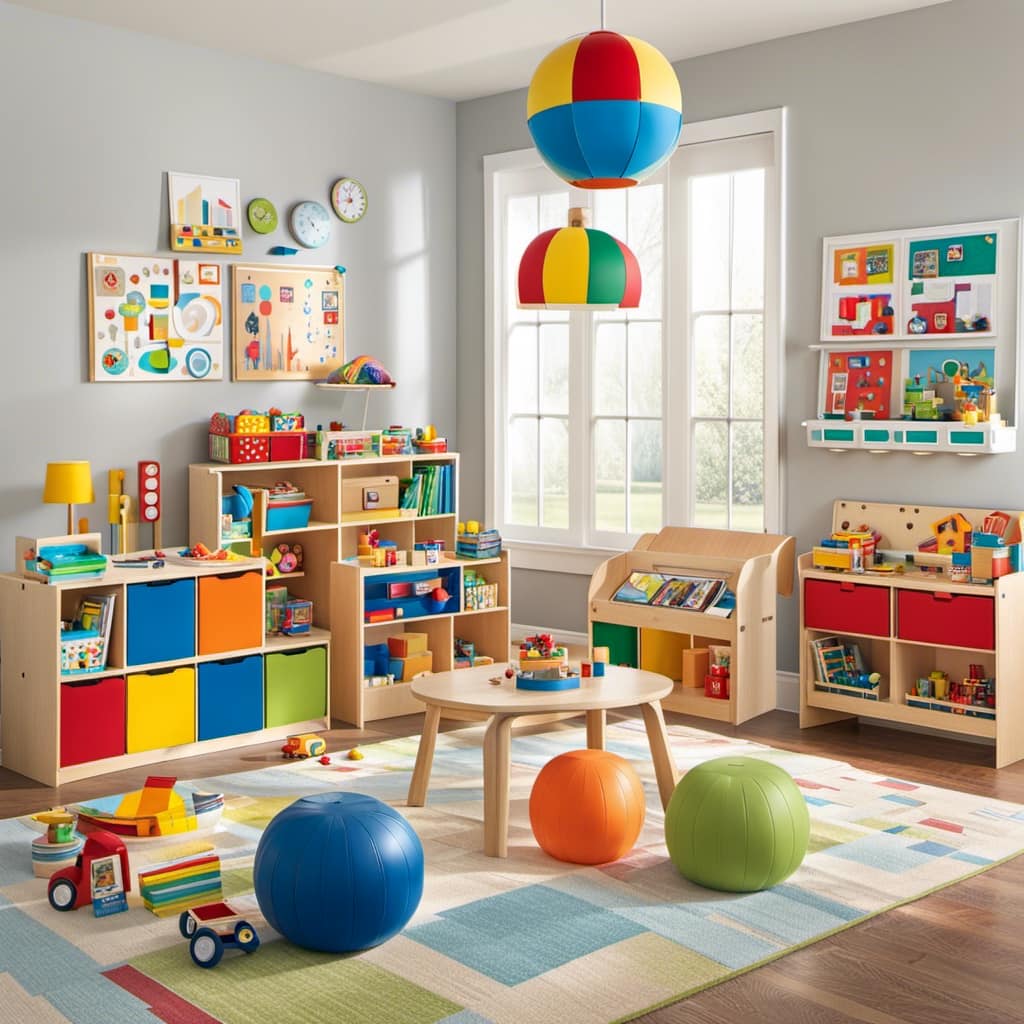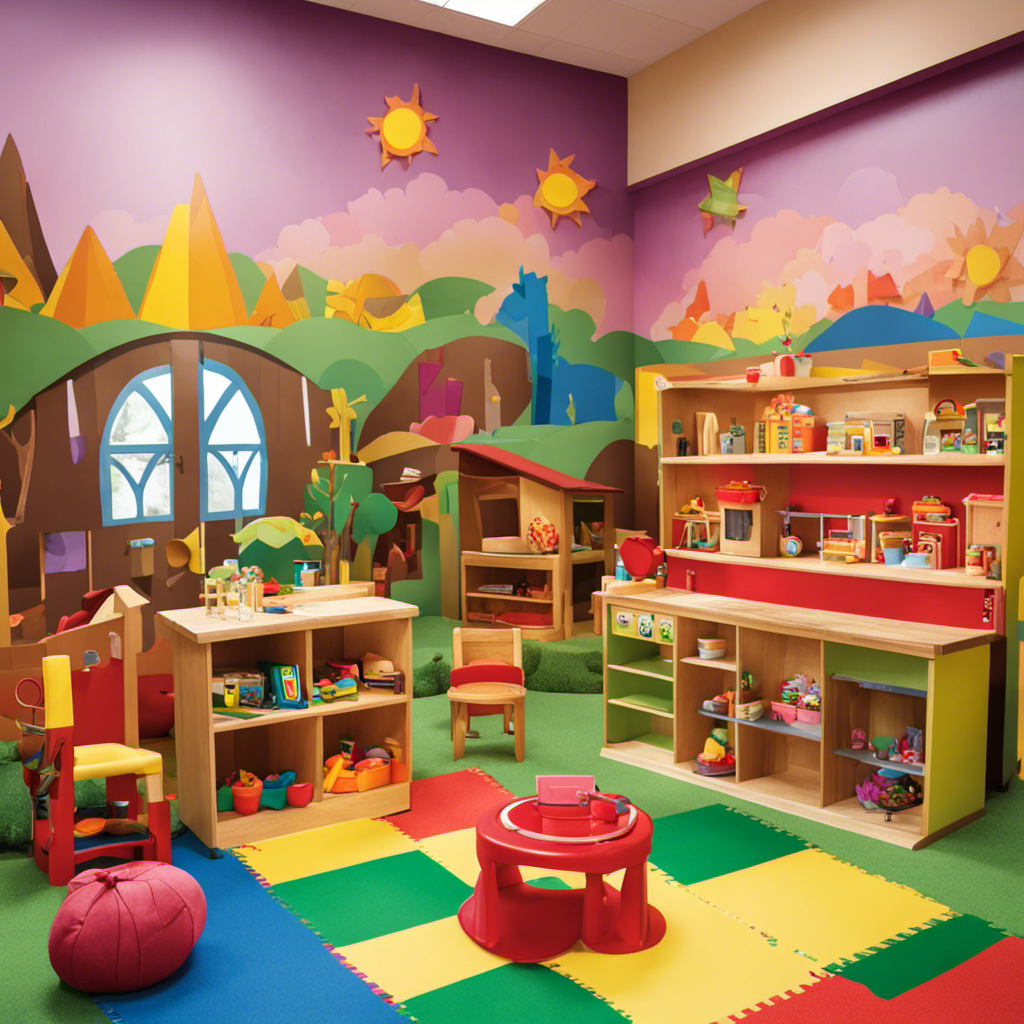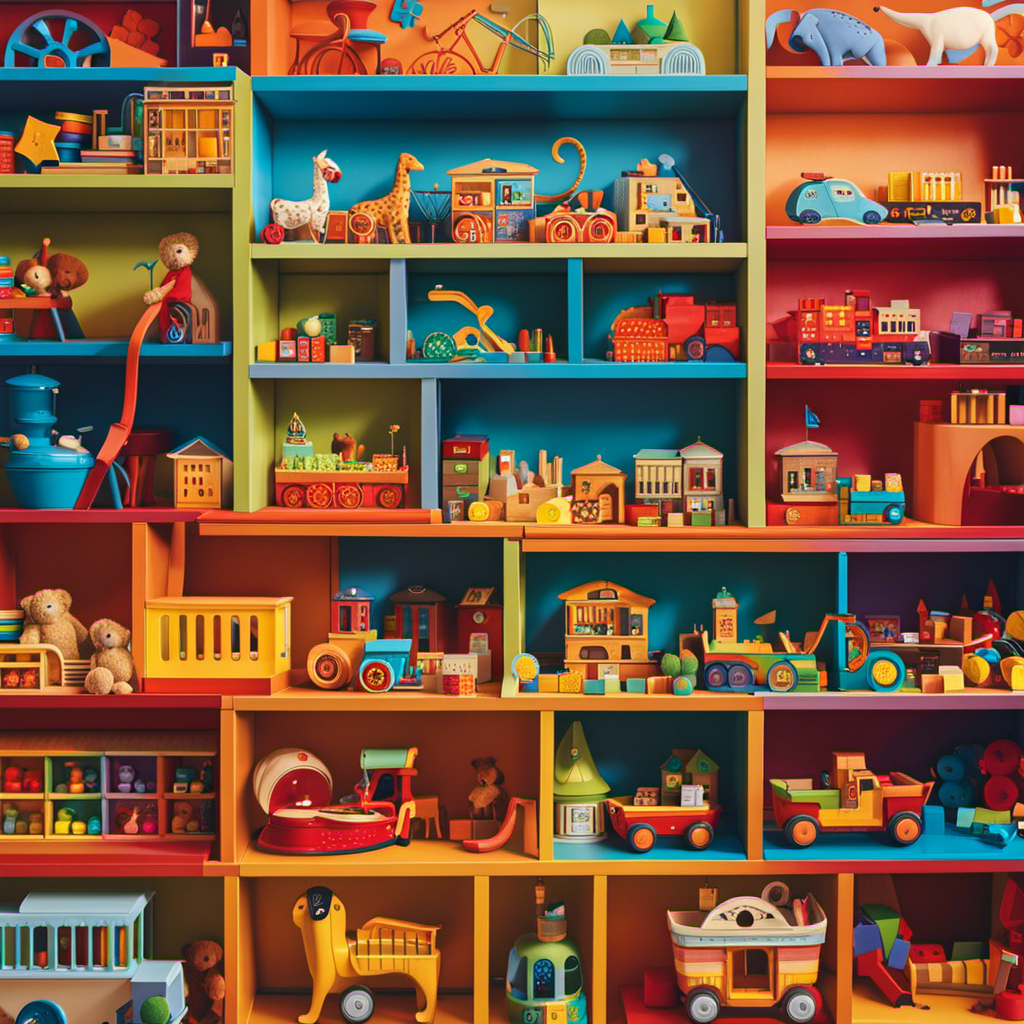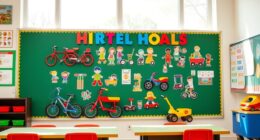As a preschool teacher, I understand the importance of keeping materials and toys organized. It’s like running a well-oiled machine where everything has its place and is easily accessible.
In this article, I will share practical tips and strategies for organizing preschool supplies and toys. From sorting and categorizing to creating a storage system, I will guide you through the process of maintaining a clean and sanitized environment while ensuring that your little ones have a fun and engaging learning space.
Let’s dive in!
Key Takeaways
- Sort supplies into categories such as art materials, manipulatives, books, and educational games.
- Invest in practical storage solutions like clear plastic bins with labels.
- Utilize vertical storage with stackable bins or shelves.
- Use clear containers or bins to store smaller items for easy visibility.
Sorting and Categorizing Supplies
You can start by sorting and categorizing your supplies to make them easier to find and use. This is an essential step in creating a well-organized and efficient storage system for your preschool supplies and toys. By sorting your supplies into different categories, such as art materials, manipulatives, books, and educational games, you can easily locate and access what you need when planning activities for your little ones.
To achieve this, invest in storage solutions that are practical and functional. Clear plastic bins or containers with labels can help keep everything organized. Consider using stackable storage bins to maximize space and make it easier to find specific items. Additionally, using smaller containers within the larger ones can further separate and categorize your supplies.
Incorporating toy maintenance into your sorting and categorizing process is crucial. Regularly check your toys for any damage or missing parts and remove them if necessary. This will ensure the safety of your preschoolers and prolong the lifespan of your toys.
Creating a Storage System
When creating a storage system for your preschool materials, it’s important to consider the size and accessibility of the containers. Maximizing space and finding efficient storage solutions can make a big difference in keeping your classroom organized and clutter-free. Here are a few tips to help you create an effective storage system:
First, assess the size of your materials and choose containers that can accommodate them. Opt for clear bins or baskets that allow you to easily see what’s inside. This will make it easier for both you and the children to find and access the materials they need.
To help you visualize the benefits of an organized storage system, let’s take a look at this table:
| Category | Container Type | Benefits |
|---|---|---|
| Art Supplies | Stackable Drawers | Easy access, space-saving |
| Books | Bookshelves | Promotes reading, organized display |
| Manipulatives | Clear Bins | Visual appeal, easy cleanup |
| Puzzles | Shelf Dividers | Neat organization, prevents lost pieces |
| Costumes | Hanging Rack | Maximizes vertical space, easy to see options |
By utilizing these storage solutions, you can make the most of your classroom space and create an environment that fosters learning and creativity.
Now, let’s transition to the next section on utilizing shelf space effectively without writing a step.
Utilizing Shelf Space Effectively
Utilizing shelf space effectively can enhance organization and maximize the storage capacity of your classroom. When it comes to organizing preschool supplies and toys, every inch of shelf space counts. Here are some practical tips for maximizing space and finding the best storage solutions:
-
Vertical Storage: Utilize the vertical space by using stackable bins or shelves. This allows you to make the most out of limited floor space.
-
Clear Containers: Use clear containers or bins to store smaller items. This makes it easier to see what’s inside without having to open each container, saving you time and effort.
-
Categorize and Label: Categorize your supplies and label each container or bin accordingly. This not only helps you find things quickly but also encourages children to clean up after themselves.
-
Utilize Wall Space: Install wall-mounted shelves or hooks to store larger items or items that are frequently used. This frees up valuable shelf space for other items.
-
Rotate Supplies: To maximize space even further, consider rotating supplies. Keep some items in storage and switch them out periodically, keeping the classroom fresh and exciting.
By utilizing these storage solutions and maximizing your shelf space, you can create a well-organized and efficient classroom environment.
Speaking of organization, let’s now move on to the next important step: labeling containers and bins.
Labeling Containers and Bins
Labeling containers and bins helps you quickly identify and locate items in your well-organized classroom. When it comes to sorting and labeling techniques, there are a few key strategies that can make your life much easier.
First, consider using clear plastic bins or containers with lids. These not only allow you to see the contents at a glance but also help maintain cleanliness and sanitation by keeping dust and dirt out.
Next, choose a labeling system that works for you and your students. You could use color-coded labels for different categories of materials, such as art supplies, books, or toys. Alternatively, you could use picture labels for younger children who may not be able to read yet. Whichever method you choose, make sure the labels are clear and easy to read.
Lastly, regularly review and update your labeling system to ensure it remains effective. By implementing these sorting and labeling techniques, you can maintain a well-organized classroom and easily locate materials when you need them.
When it comes to organizing art and craft materials, there are a few additional considerations to keep in mind.
Organizing Art and Craft Materials
To keep your art and craft materials organized, it’s important to have designated storage areas for different types of items. Categorizing art supplies and storing craft materials not only makes it easier to find what you need but also helps to prolong the life of your materials.
One of the best ways to categorize art supplies is by type. For example, you can have separate containers for paints, brushes, and paper. This way, you can easily locate the specific item you need without rummaging through a jumbled mess. It’s also helpful to label each container so that you know exactly what’s inside.
For storing craft materials, consider using clear bins or drawers so that you can see the contents at a glance. This makes it easier to find what you need and prevents items from getting lost or damaged. Additionally, you may want to consider using smaller containers within the larger bins to further categorize and organize your materials.
By taking the time to categorize and store your art and craft supplies properly, you’ll save time and frustration when it comes to creating your next masterpiece.
When it comes to storing manipulatives and learning tools, organization is key. By having designated storage areas for these items, you can ensure that they are easily accessible and ready for use whenever you need them.
Storing Manipulatives and Learning Tools
When storing manipulatives and learning tools, it’s important to designate specific areas so that you can easily find and access them as needed. One way to do this is by creating separate storage containers or shelves for different types of manipulatives.
For example, you could have a container specifically for math manipulatives like counting cubes and pattern blocks, and another container for language and literacy manipulatives like letter tiles and sight word cards. This not only helps keep everything organized, but it also makes it easier for both teachers and students to locate and use the materials.
In addition to organizing manipulatives, it’s also important to have a system for storing art supplies. Consider using clear plastic bins or drawers to store items such as markers, crayons, paintbrushes, and glue sticks. Label each container with the specific art supply to make it easier for children to find what they need.
You can also create a designated area for sensory bins, which are a great way to promote sensory exploration and play. Use large plastic bins or trays to store sensory materials like sand, water beads, or rice, and keep them in a designated area where children can easily access and explore them.
Transitioning into managing books and reading materials, it’s important to create a cozy and inviting reading corner in your preschool classroom.
Managing Books and Reading Materials
After successfully organizing all the manipulatives and learning tools, it’s time to tackle the task of managing books and reading materials in my preschool classroom.
A well-organized book storage system is essential to create a cozy and inviting reading corner for the little ones. First, I will sort the books into different categories such as fiction, non-fiction, picture books, and reference books. This will make it easier for both the teachers and the children to find the right book at the right time.
I will then invest in sturdy bookshelves or bins to store the books. Labeling each section or bin will help maintain order and make it easier for the children to put the books back in their designated spots.
To create a reading corner, I will place a comfortable rug or cushions, along with a small table or book display stand. Adding some soft lighting and cozy decorations will help create a warm and inviting atmosphere.
Now that the books are organized and the reading corner is set up, it’s time to move on to the next task of setting up a sensory play area.
Transition: With the books sorted and the reading corner ready, it’s time to explore the exciting world of sensory play.
Setting Up a Sensory Play Area
Setting up a sensory play area in your preschool classroom can provide numerous benefits for your students. Sensory play allows children to explore and engage with their environment using their senses, promoting cognitive development and creativity.
To create an effective sensory play area, it is important to have essential sensory materials such as sand, water, playdough, and various textures. Organizing sensory play involves creating designated areas for different sensory experiences and ensuring that materials are easily accessible and stored properly.
Sensory Play Benefits
To maximize your child’s development, it’s important to understand the benefits of sensory play. Sensory play engages your child’s senses, allowing them to explore, learn, and develop essential skills. Here are some sensory play ideas and materials that can enhance your child’s learning experience:
- Kinetic sand: This moldable sand provides a tactile experience, promoting fine motor skills and creativity.
- Water play: Splashing in water helps develop hand-eye coordination and sensory exploration.
- Playdough: Squeezing, rolling, and shaping playdough improves hand strength and coordination.
- Sensory bins: Filled with rice, beans, or other materials, sensory bins offer opportunities for tactile exploration and imaginative play.
- Texture cards: These cards introduce different textures, helping children develop tactile discrimination.
Essential Sensory Materials
One important material for sensory play is sand, which provides a tactile experience and promotes fine motor skills and creativity. When it comes to sensory play ideas, sand is a versatile and engaging option.
Children can dig, scoop, and pour it, using their hands or various tools. They can build sandcastles, create patterns, and explore textures. Not only does sand offer endless possibilities for imaginative play, but it also has numerous sensory play benefits. It helps children develop hand-eye coordination, strengthen their fingers, and improve their spatial awareness. Sand play can also be calming and therapeutic, allowing children to relax and unwind.
By incorporating sand into your sensory play activities, you can create a rich and stimulating environment for your little ones.
Now, let’s explore how to organize sensory play without any disruption to the flow of the activities.
Organizing Sensory Play
When planning sensory play activities, it is important to have a designated space that is easily accessible and free of distractions. This will allow children to fully engage and explore their senses.
Here are some sensory play ideas to spark creativity and learning:
- Create a sensory bin filled with rice, beans, or sand for tactile exploration.
- Set up a water table with various containers and toys for water play.
- Provide a sensory art station with different textures and materials for hands-on creativity.
These sensory play materials not only entertain children but also help develop their fine motor skills, cognitive abilities, and sensory processing. By incorporating these activities into your preschool curriculum, you are offering valuable opportunities for growth and learning.
Now, let’s transition into organizing outdoor play equipment without missing a beat.
Organizing Outdoor Play Equipment
It’s important to designate a specific area for storing outdoor play equipment. Having a designated space not only keeps the area tidy but also makes it easier for children to access and put away their toys.
When it comes to organizing sports equipment, there are several outdoor storage options available. One option is to use bins or baskets to store smaller items like balls, frisbees, and jump ropes. These can be placed on shelves or in a designated storage cabinet. For larger items like bicycles or scooters, a bike rack or wall hooks can be installed to keep them off the ground and out of the way. Another option is to use a storage shed or outdoor storage box to keep all the outdoor play equipment in one place. This not only keeps the area organized but also protects the toys from the elements.
By having a designated area for outdoor play equipment, it becomes easier for children to find and put away their toys, fostering independence and responsibility.
Now, let’s move on to tidying up dramatic play materials.
Tidying Up Dramatic Play Materials
To keep the dramatic play area neat and organized, you can use labeled bins for storing costumes and props. This is a practical solution that ensures everything has its place and is easily accessible for the children.
When it comes to dramatic play, inspiration can come from various sources. Role playing activities allow children to explore different roles and situations, fostering their imagination and creativity. Having a well-organized dramatic play area not only makes it easier for children to find what they need but also encourages them to engage in role play more frequently.
By using labeled bins, you can categorize costumes and props based on themes or types. For example, you can have a bin labeled ‘Community Helpers’ where you store costumes related to different professions, such as firefighter hats, doctor coats, and police officer badges. Another bin labeled ‘Fantasy’ can contain capes, crowns, and fairy wings. This way, children can easily find what they need and put them back in the right place after they finish playing.
Transitioning to the next section about keeping games and puzzles in order, it is essential to maintain organization in all areas of the classroom.
Keeping Games and Puzzles in Order
When it comes to keeping games and puzzles in order, there are a few key points to consider.
First, sorting puzzle pieces is essential to ensure that each puzzle is complete and ready for play.
Secondly, storing game boxes properly helps to prevent damage and keep all the pieces together.
Lastly, labeling toy containers can make it easier for children to find and put away their games and puzzles independently.
Sorting Puzzle Pieces
Start by gathering all the puzzle pieces and sorting them into different categories based on their colors or shapes. This puzzle organization technique not only helps keep the pieces organized, but also aids in the development of sorting skills in preschoolers. By sorting the puzzle pieces, children learn to identify similarities and differences, improving their cognitive abilities. Here is a useful table to guide you in sorting the puzzle pieces:
| Category | Color | Shape |
|---|---|---|
| Animals | Brown | Circle |
| Vehicles | Red | Square |
| Nature | Green | Triangle |
Once you have sorted the pieces into their respective categories, you can easily find and assemble the puzzles. This method of puzzle organization ensures that all pieces are accounted for and makes it simpler to store them in their designated places. Speaking of storage, let’s move on to the next section about storing game boxes without cluttering your space.
Storing Game Boxes
After successfully sorting puzzle pieces, it’s time to tackle the next challenge: organizing board games and storing toy boxes.
Board games are a great educational tool for preschoolers, but keeping all those boxes and pieces in order can be a daunting task. To start, find a designated shelf or cabinet where you can store the games. Make sure it’s easily accessible for both teachers and children. Keep the game boxes upright and neatly stacked to prevent any damage. For smaller games, consider using clear plastic bins or ziplock bags to keep all the pieces together. This will not only save space but also make it easier to find what you’re looking for.
Now that the games are organized, let’s move on to the next step: labeling toy containers…
Transitioning into the next section, let’s discuss the importance of labeling toy containers.
Labeling Toy Containers
To keep things organized, you’ll want to label the toy containers with clear and descriptive tags. This will make it easier for both teachers and children to find and put away toys in their designated spots.
Here are three reasons why labeling toy containers is essential:
-
Efficiency: With clear labels, you can quickly identify where each toy belongs, saving time and effort when tidying up.
-
Independence: By using visual labels, even young children can learn where toys should be stored, encouraging them to take responsibility for cleaning up after playtime.
-
Accessibility: Labeled toy containers allow children to easily find and choose the toys they want to play with, promoting independence and creativity.
By organizing stuffed animals and labeling toy shelves, you create an inviting and functional space for children to explore and play.
And, in order to maintain a clean and sanitized environment, it’s important to establish a regular cleaning routine.
Maintaining a Clean and Sanitized Environment
It’s important to regularly clean and sanitize the preschool supplies and toys to maintain a healthy environment. As a preschool teacher, I understand the importance of creating a clean and safe space for the children to play and learn. Establishing a cleaning schedule and using effective disinfecting methods will help prevent the spread of germs and keep the children healthy.
To ensure thorough cleaning, I follow a cleaning schedule that outlines specific tasks for each day. This schedule includes wiping down surfaces, cleaning and disinfecting toys, and sanitizing shared items such as tables and chairs. By following a consistent schedule, I can maintain a clean environment and reduce the risk of germs spreading.
When it comes to disinfecting methods, I use a variety of techniques to ensure all surfaces and toys are properly cleaned. I have found that a combination of disinfectant wipes, cleaning sprays, and bleach solutions are effective in killing germs. I also make sure to pay extra attention to high-touch areas such as doorknobs, light switches, and toy handles.
By regularly cleaning and sanitizing the preschool supplies and toys, I am able to create a healthy environment for the children. This not only prevents the spread of germs, but also promotes a positive and safe learning experience.
In the next section, I will discuss the importance of rotating toys and supplies to keep the children engaged and stimulated.
Rotating Toys and Supplies
Rotating toys and supplies in a preschool setting offers numerous benefits. Not only does it help keep the environment fresh and exciting for the children, but it also promotes creativity and problem-solving skills.
As an educator, I have found that implementing organization tips and tricks, such as labeling bins and creating a rotating schedule, can make the process much smoother. Additionally, providing engaging playtime options, such as themed play areas or sensory bins, can further enhance the learning experience for the children.
Benefits of Rotation
The benefits of rotating preschool supplies and toys are numerous. Not only does it keep things fresh and exciting for the children, but it also promotes learning and development in various areas. Through toy rotation, children are exposed to different types of toys, allowing them to explore new interests and develop different skills. Additionally, toy organization becomes much easier when you have a system in place for rotating toys. You can use a simple table to keep track of which toys are currently available and which ones are stored away. Here’s an example:
| Category | Current Toys | Stored Toys |
|---|---|---|
| Blocks | Wooden Blocks | Lego Duplo |
| Art Supplies | Crayons | Watercolors |
| Puzzles | Animal Puzzle | Number Puzzle |
By rotating the toys every few weeks or months, you can create a sense of novelty and maintain children’s interest. It’s a win-win situation for both children and parents, as it keeps the playtime engaging and the toy collection organized.
With a better understanding of the benefits of toy rotation, let’s now move on to some organization tips and tricks.
Organization Tips and Tricks
Now let’s explore some tips and tricks for keeping things organized.
When it comes to managing preschool supplies and toys, sorting and categorizing is key. Start by grouping similar items together, such as art supplies, building blocks, and pretend play props. This will make it easier to find what you need and keep everything tidy.
Once you’ve sorted everything, labeling containers and bins is a fantastic way to stay organized. Use clear and concise labels that are easy to read, so you know exactly where each item belongs. Not only does this save time, but it also teaches children the importance of returning items to their designated spots.
With supplies and toys neatly sorted and labeled, you’ll have more time to focus on engaging playtime options that stimulate learning and creativity.
Engaging Playtime Options
When it’s time for play, there are countless options to keep preschoolers engaged and excited. As an early childhood educator, I have found that incorporating interactive play options is key to capturing their attention and promoting learning. Here are some engaging playtime ideas that have been a hit in my classroom:
| Activity | Materials Needed | Benefits |
|---|---|---|
| Sensory bins | Rice, beans, small toys, scoops | Encourages exploration and fine motor skills |
| Puppet shows | Hand puppets, small stage | Enhances creativity and storytelling abilities |
| Obstacle course | Cushions, hula hoops, cones | Promotes physical development and problem-solving |
Frequently Asked Questions
How Do I Handle Supplies That Don’t Fit Into Any Specific Category?
When it comes to handling miscellaneous supplies, finding storage solutions can be a bit tricky.
It’s important to first assess the items and see if any can be grouped together based on similarity or function.
If not, consider using storage bins or containers that can accommodate various items.
Label each container clearly so you know what’s inside.
Another option is to designate a separate area for these supplies, such as a shelf or cabinet, so they don’t clutter up other organized spaces.
What Are Some Creative Storage Solutions for Small Classrooms?
Innovative storage solutions are crucial for effective classroom space management. From my experience, finding creative ways to store materials in a small classroom can make a big difference.
I’ve discovered that utilizing vertical space with hanging organizers or wall-mounted shelves can maximize storage without sacrificing floor space. Additionally, using stackable bins or baskets can help keep supplies organized and accessible.
These practical strategies have allowed me to create an organized and efficient learning environment for my preschoolers.
How Can I Prevent Art and Craft Materials From Getting Mixed Up?
To prevent art and craft materials from getting mixed up, I find it helpful to have designated storage containers for each type of material. This way, everything has its place and it’s easy for me and the children to find what we need.
I also like to use clear, labeled bins, so it’s easy to see what’s inside without having to open each one. It saves time and keeps our art area organized and tidy.
Are There Any Specific Guidelines for Organizing Manipulatives and Learning Tools?
When it comes to organizing manipulatives and learning tools, there are definitely some guidelines that can make your life much easier.
Effective strategies for managing preschool supplies and toys involve categorizing items based on their purpose or theme. This not only helps with finding what you need quickly, but also encourages a more structured and organized learning environment for the little ones.
How Often Should I Rotate Toys and Supplies to Keep Things Fresh and Engaging for the Children?
To keep things fresh and engaging for the children, I believe it’s important to establish a rotating schedule for toys and supplies. By regularly switching out items, you can provide variety and stimulate their curiosity.
This can be done weekly or bi-weekly, depending on your preference and the number of materials available. It’s a simple yet effective way to maintain their interest and promote a dynamic learning environment.
Conclusion
So there you have it, a guide to organizing preschool supplies and toys.
By sorting and categorizing your materials, creating a storage system, and utilizing shelf space effectively, you can create a well-organized and functional learning environment for your little ones.
Don’t forget to label containers and bins, tidy up dramatic play materials, and keep games and puzzles in order.
It’s also important to maintain a clean and sanitized environment for the health and safety of everyone.
And remember, just like rotating toys and supplies keeps things fresh and exciting for the children, organizing and decluttering can bring a sense of renewal and efficiency to your preschool space.
So roll up your sleeves, get organized, and watch your students thrive!
Tina is the heart and soul behind Toddler Ride On Toys. With a passion for early childhood education and a deep understanding of child development, Tina ensures that every piece of content on our website reflects our commitment to playful learning. Her expertise in Montessori, Preschool, STEM, and Waldorf education philosophies helps shape our website into a valuable resource for parents, caregivers, and educators.
